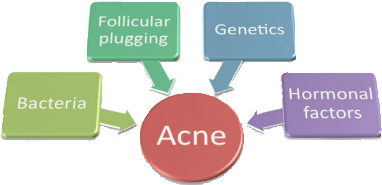Causes of Acne
The formation of acne is the end result of many factors
A lot of people wonder why they have acne and how it formed. Let our dermatologists explain the process. It seems there would be a simple answer, but actually, the formation of acne is the end result of many factors. The entire process starts with a structure called the pilosebaceous unit. This is a structure that is found in everyone's skin, and it is made up of the hair follicle, the sebaceous (oil-producing) glands, the erector pili muscle (it makes hair stand on its end and is responsible for goosebumps), and sebum (also known as oil). The highest number of pilosebaceous units is found on the face, upper back, and upper chest.
Since this pilosebaceous unit is the root of the problem, it is no surprise that the face, upper chest, and upper back are the areas most commonly affected by acne. The earliest change that occurs in a pilosebaceous unit is a process known as follicular plugging. The hair, sebum, and keratinocytes (skin cells) can together start blocking the opening of the hair follicle, thereby keeping the sebum from leaving the skin through a pore. This results in the formation of what is known as the microcomedo, or a small plug that starts leading to acne formation. Once a microcomedo forms, other factors can then come into play. These include bacteria, sebum production, hormones, genetics, diet, stress, and body mass index. Many of these factors are discussed below. A good understanding of these factors is important, because we often target our treatment based on the underlying contributing factors.
Bacteria are a well-known contributing factor to the development of acne, and this is discussed further in another section.


